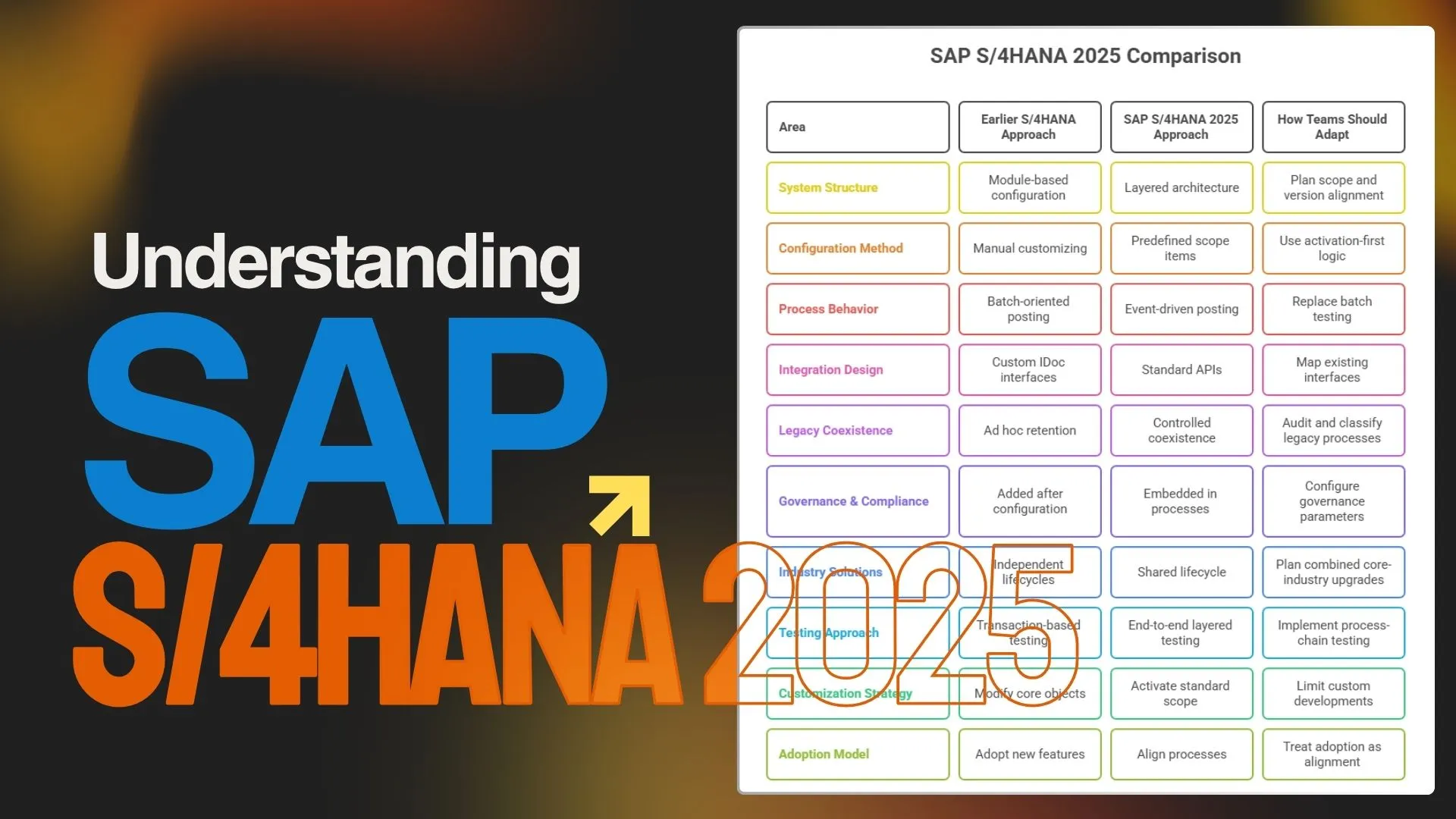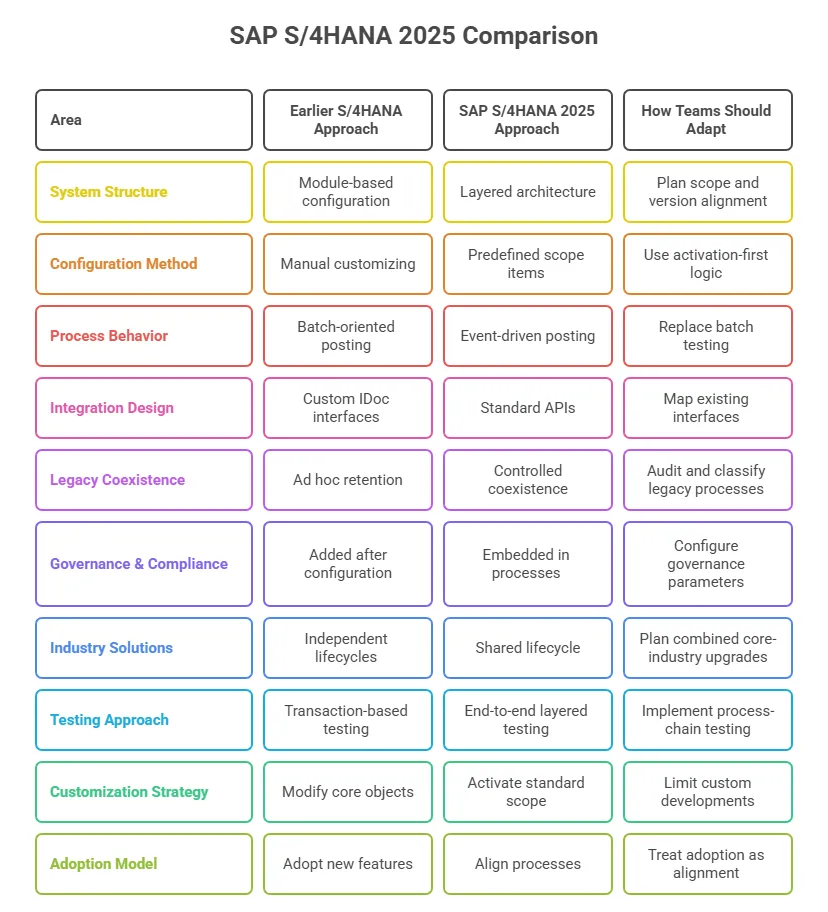TEAM SAP Vista
Typically replies in a few hours
Customer Care Team
Hi there
How can i help you today?
How can i help you today?

Start Whatsapp Chat


SAP S/4HANA 2025 changes how the system behaves at its core. The shift isn’t about new modules or features — it’s about structure, timing, and control.
Every process, integration, and governance rule now runs inside a more disciplined framework. For teams that configure, test, or manage SAP systems, this release demands new habits and deeper understanding.
“SAP S/4HANA 2025 doesn’t reward those who customize faster;
it rewards those who configure smarter.”

SAP S/4HANA 2025 organizes business logic around defined frameworks instead of feature stacks. This means configuration, data models, and integration follow a uniform structure across all areas. The focus is consistency — a move away from module-by-module behavior toward shared lifecycle rules. The result is less variation in how transactions, analytics, and reporting behave across processes.
Teams used to treating finance, logistics, and manufacturing as separate pillars will notice the difference immediately. Process orchestration is unified — and that requires more attention to dependency management and scope alignment.
The 2025 core is smaller, cleaner, and more predictable. Processes that previously used different posting methods now rely on shared document flows and master data references. This simplifies tracking and audit consistency but also raises the importance of configuration discipline.
The change is visible in posting chains. Financial, material, and order data now share consistent identifiers. That means errors replicate faster — but so does transparency. System administrators and developers must focus on clean master data because dependency handling is now automatic.
In SAP S/4HANA 2025, most functions are activated — not custom built. SAP delivers predefined scopes that you can enable, extend, or deactivate. This reduces complexity but also limits improvisation. Every activated item brings dependencies that affect testing, performance, and lifecycle.
Teams must adapt configuration strategy. Instead of asking “what can we modify,” the question becomes “what should we activate.” This change improves stability but requires detailed scope management and version tracking.
Posting logic is now event-based. Revenue recognition, accounting, and operational processes update as events occur, not through overnight jobs.
Predictive accounting generates forecast entries alongside actuals — providing live financial impact before posting.
This removes latency but changes testing completely. Batch testing no longer shows end-state accuracy; event simulation does. Quality assurance now focuses on event triggers, real-time postings, and process continuity. Finance, logistics, and manufacturing all share this behavior, meaning integration testing is no longer optional.
Integration is no longer treated as external development. SAP S/4HANA 2025 defines standard APIs and event channels for BTP, SuccessFactors, Ariba, and external systems. Each interface follows versioned definitions that survive upgrades — reducing breakpoints between systems.
For integration teams, this means less build, more validation. Instead of designing payloads, focus shifts to selecting correct API versions and verifying data consistency. Event-driven design replaces middleware dependency for most standard scenarios. In short, integration has moved from coding to configuration.
Compatibility packs govern how older components coexist with the 2025 core. They define what remains active, what is restricted, and what will sunset. This is SAP’s approach to managing hybrid system behavior — keeping legacy functions alive during transition without rewriting everything.
Teams can no longer treat coexistence as “keep what works.” Each legacy process must be mapped to a compatibility category. This forces clarity — and ensures a measured migration path. The benefit is reduced disruption; the cost is stricter lifecycle management.
Data protection and governance are not optional layers anymore — they are embedded in process configuration. Access control, read logging, and data retention policies exist at the transaction level. Compliance is no longer a post-go-live exercise; it starts during configuration.
This requires closer coordination between technical, audit, and data teams. Retention logic, access authorizations, and audit trails must be validated as part of the build cycle. The upside is that compliance behavior becomes measurable — not assumed.
Industry-specific content for automotive, utilities, public services, and retail now runs on the same master data model and update cadence as the core system. This brings predictability but removes flexibility in patch scheduling.
Project teams must plan for synchronized upgrades. Industry updates are no longer independent; they arrive when the core updates. Custom enhancements in industry areas must follow standard lifecycles to remain supported.
Testing practices built for older SAP versions won’t work as-is in S/4HANA 2025.
The layered architecture — core, LoB, industry, integration, and governance — means that even minor activation changes can affect connected areas.
Testing must now include:
Automated test scripts must simulate continuous operations instead of single transactions. Regression testing must include compatibility pack transitions. Teams that adjust early will see fewer production regressions later.
Adoption no longer means installing new functionality; it means aligning with the release’s structure. Each process must match SAP’s standardized scope. This requires verifying custom developments, extensions, and third-party integrations against defined scope items.
Enterprises that approach adoption as alignment — not customization — will see fewer transport conflicts and cleaner upgrade cycles. The emphasis is on structural readiness: understanding how processes fit into SAP’s current architecture before starting migration.
SAP S/4HANA 2025 favors predictable change over rapid reinvention. The release aims for one thing — consistency. Teams that understand its structural logic will gain stability, faster testing cycles, and better upgrade predictability.
For most organizations, the immediate task is to build familiarity with how the 2025 system behaves. Testing configuration, event flows, and compatibility layers in isolated environments will provide the insights required for planning.
At SAPVista, we’re currently testing the SAP S/4HANA 2025 release internally — observing how these architectural patterns operate in live systems. Once validation is complete, the 2025 version will be available in our catalogue for teams who want to explore its behavior firsthand.
.webp)
SAP Lead Consultant and Director of Business Strategy at Altzen Technologies Private Limited.